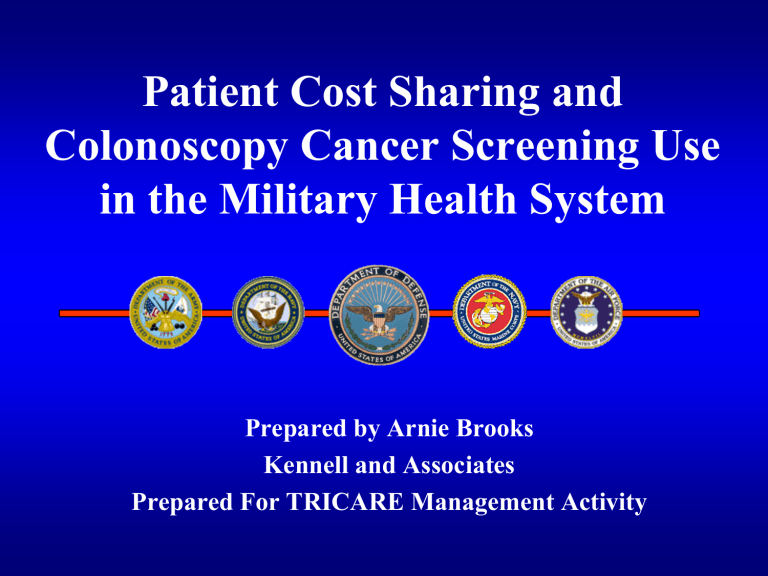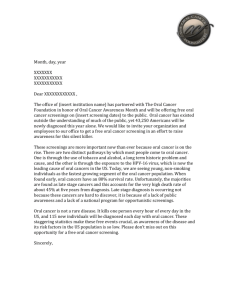Patient Cost Sharing and Colonoscopy Cancer Screening Use Prepared by Arnie Brooks

Patient Cost Sharing and
Colonoscopy Cancer Screening Use in the Military Health System
Prepared by Arnie Brooks
Kennell and Associates
Prepared For TRICARE Management Activity
Importance of Colorectal Cancer Screening
• 150,000 people/year are diagnosed & 50,000 die of CRC.
– CRC is the second leading cause of cancer death in US.
• U.S. Preventive Services Task Force, the American Cancer
Society, and others recommend regular interval CRC screenings for people age 50+.
• The National Commission on Prevention Priorities found:
– CRC screening is among the most cost-effective of all preventive services.
– Up to 30k additional lives/year could be saved in US if more adults were up-to-date with CRC screenings.
• Would reduced cost sharing increase CRC screenings?
2
No Published Articles Found Directly Addressing
Relationship Between Cost Sharing & CRC Screenings
• However, analytic studies over three decades confirm that lower cost sharing results in higher medical care use.
• RAND HIE:
– patients with no cost sharing had 37% more office visits than patients who paid 25% of cost.
– within 0-25% cost sharing ranges, price responsiveness was similar for different types of care (chronic/acute/preventive).
• Cherkin et al. (1990): with the imposition of a $5 copayment, preventive visits fell by 14%.
• Trivedi et al. (2008): mammography screening rates were 8.3% lower in plans that required $10+ copays.
3
Study Questions
• “Gold Standard” colonoscopies have had large patient cost sharing for some TRICARE beneficiaries, which may have significantly deterred screening compliance.
• TRICARE legislation (NDAA 09) eliminated cost sharing for colorectal , breast, cervical, & prostate cancer preventive screenings.
• Key Questions: Will colonoscopy cost sharing elimination significantly increase screening rates?
– and if so, by how much?
4
TRICARE Claims Allow for Unique Analysis
• TRICARE civilian “purchased care” claims offer a unique opportunity for analysis of the effects of cost sharing.
• In TRICARE, two groups paid no cost sharing for preventive services provided in the civilian “purchased care” market:
– Civilian HMO Enrollees
– Non-enrollees who have other health insurance (OHI)
• Alternatively, another full cost sharing group (non-HMO patients without OHI) paid $100-$150 per colonoscopy:
– Allowed cost of $500-$600, coinsurance of 20% to 25%
5
TRICARE Population Sampled
• Age 50+ active duty family members and non-Medicare eligible retirees & dependents are included in the population:
• Active duty service members & Medicare eligibles are excluded because they have no variation in cost sharing.
• All care from Military Treatment Facilities (MTFs) excluded.
– MTF care is free, so no MTF user cost sharing variation.
• Included only civilian “purchased care” utilization for non-
MTF users living far from MTFs.
• Users are those who had one+ E&M visit in FY06 or FY07.
• Sample: 611,584 lives age 50+ living far from MTFs.
6
Dependent Variable Definition-CRC Screenings
• Kept users’ first CRC screening test in FY06 & FY07.
All later tests excluded because most likely diagnostic.
• Few barium enema & virtual colonoscopy claims and thus both were excluded from sample .
• FOBT tests also excluded since cost sharing on a $4.69 test would be inconsequential to patient decision.
• Thus we analyze invasive CRC screenings. Colonoscopy cost sharing can be about $100-$150/procedure.
• Colonoscopies reflect true patient choice: they have several weeks to consider cost/benefit consequences.
7
Key Independent Variables:
3 Cost Sharing User Groups
• CostShr: non-HMO users without OHI—patient paid TRICARE cost sharing of 20% to 25% of allowed costs—$100-$150 for colonoscopies.
• NonHMONoCstShr: non-HMO users with OHI, so almost always the patient paid no cost sharing.
• HMONoCstShr: HMO enrollees—TRICARE charges no cost sharing for any preventive benefits.
8
Additional Independent Variables
• Reported CRC History : A claim record coded for family history; implies greater propensity for colon screenings.
• Screening Year : Expect use in FY07 > FY06 given general medical utilization increases over time.
• Age and Gender :
– CRC incidence increases with age; expect screening rates to increase with age up to a point.
– Gender often plays a role in medical services use.
• Military Rank of Sponsor: Rank is a surrogate for income/education; possibly related to colonoscopy use.
9
Model Specification
• Dichotomous choice, cross-section time-series logistic regression.
• Dependent variable is the natural log of the odds of a
TRICARE user choosing a screening colonoscopy:
– constrains use probability to be between 0 & 1.
• Model output: expected probability of use for three cost sharing groups, controlling for other measured independent effects.
10
Modeling Results
Model Estimated Annual Preventive Colonoscopy
Use Rates in FY06 & FY07
CostShr NonHMONoCstShr HMONoCstShr
Use Rate
Incr. vs. CostShr
7.66% 10.26%
34% 1/
11.44%
49% 1/
1/ P < .0001
• Other variables that have a statistically significant affect on use :
– users with CRC family history
– users with officer sponsors
– users who are older up to age 65
– women
– FY 07 use
11
Modeling Results
(Continued)
Summary & Conclusions
• $100-$150 cost sharing for colonoscopy screenings has likely greatly reduced compliance rates.
• NDAA09 could increase screening rates by as much as 35%-50% for those who paid cost sharing.
• This result would result in greater compliance with recommended colonoscopy screenings of once every 10 years.
• Added CRC screenings are very cost-effective.
– Cost impact is minimal on Defense Health budget.
– Many lives could be saved each year.
13
Potential Study Limitations
• CRC family history, high risk patients, or diagnostic testing not well known with TRICARE administrative claims data.
• Income, education, ethnicity levels unknown.
• Potential for user group selection bias, particularly in HMO plan:
– Patients may select HMOs for preventive benefits.
– HMO providers may recommend colonoscopies more often.
– Schneider et al. (2008) suggests FFS Medicare group without supplemental insurance generally seek less medical care.
– Pseudo-randomization not feasible--data does not predict group selection (e.g. officer status, age/gender not related to plan choice).
– But some CostShr supplemental coverage may offset possible bias.
• Will be able to conduct natural experiment to test conclusions.
14

